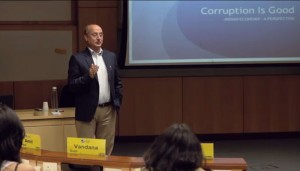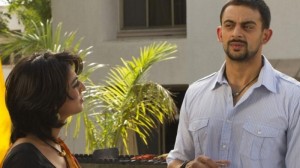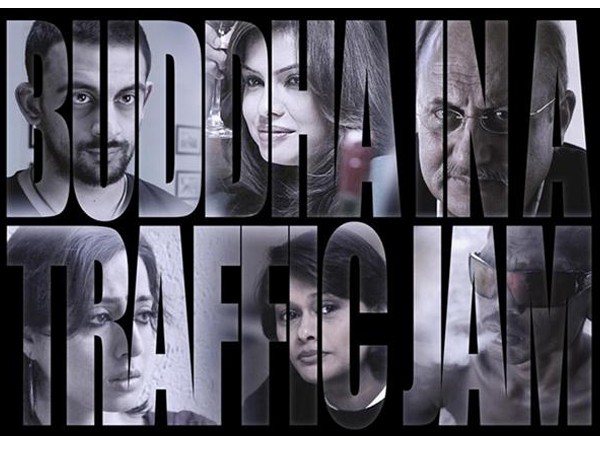Director: Vivek Agnihotri
If you ignore its blatant political idealism, there’s something inherently “filmy” about Vivek Agnihotri’s ‘Buddha In A Traffic Jam’, a film that has been making the news lately for, well, not being screened by colleges — its purported core audience. Its fierce ring-wing gaze seems like more of an enraged statement than the striking core of a campus-revolution film. If you ask me what I’ve learned through its 2-hour running time, I’d say that I could see the “twist” coming from miles away, instead of contemplating its rabble-rousing philosophy and black-and-white characters.
It starts off intriguingly with a prologue that lays the foundation for a couple of festival-film tropes: A tribal on conflicted land is torn between an obscenely corrupt government officer (who warns him not to give in to the Naxals), and an obscenely angry Maoist leader (who warns him not to give in to the babus). After which, we come to ISB Hyderabad, where a gang of chain-smoking (because, modernity and 2016) students stand on the brink of a digital revolution. One of them, our Wall-Street-returned hunky protagonist Vikram Pandit (Arunoday Singh), takes a shine to Professor Batki’s (Anupam Kher, the activist) famous “Corruption is good for the economy” lectures — rest assured, his socialist theories sound far more like agitated Twitter updates or JNU canteen chatter than well-researched course work at a premier management college. You can almost sense Dr. Dang’s theme ring out in the background when Kher ends most of his speeches.
Thus begins a fairly natural guru-shishya relationship, with Vikram attempting to help raise funding for his wife’s vague non-profit organisation. He proposes some mumbo-jumbo about how her Pottery club could make millions for the tribals by *gasp* by cutting out the middlemen in the trading process — revolutionary, indeed, if you’re three cocktails down at a house party (which is where most of these theories seem to have been conceived). But the film’s issue isn’t this simplistic exploration of what is one of India’s deepest and darkest problems; it’s the fact that Agnihotri has painted caricatures around them to make the story ‘more accessible.’ After all, this is the guy that made ‘Hate Story’ and ‘Chocolate’, so one wound’t begrudge him his evils — but why does this social media generation have to be represented as a bunch of screechy and perpetually high rebels with multiple causes?
 The notion of modern-day liberalism is insulted, not explored, when everyone is shown with a cigarette dangling out of their mouths, generally loose (with words, and living), and when an annoying girl climbs onto a bar table and sings out “I’m a bitch!” before tearing her shirt off and twirling around in her bra. It’s almost like the fiercely opinionated makers are taunting everyone who is simply going about his/her business in life, that they’re armchair activists until they are pushed to a corner. Not to mention the Bhandarkari-ish side acts, and the complete disregard for anything that dares to speak without making an outlandish point. There’s also the jhola-wearing tribal activist played by Mahie Gill, who somehow finds herself split between an erotic drama parading as a meaningful statement of intent.
The notion of modern-day liberalism is insulted, not explored, when everyone is shown with a cigarette dangling out of their mouths, generally loose (with words, and living), and when an annoying girl climbs onto a bar table and sings out “I’m a bitch!” before tearing her shirt off and twirling around in her bra. It’s almost like the fiercely opinionated makers are taunting everyone who is simply going about his/her business in life, that they’re armchair activists until they are pushed to a corner. Not to mention the Bhandarkari-ish side acts, and the complete disregard for anything that dares to speak without making an outlandish point. There’s also the jhola-wearing tribal activist played by Mahie Gill, who somehow finds herself split between an erotic drama parading as a meaningful statement of intent.
Eventually, every filmmaker trying to put across his/her views on life and country must remember the medium they’ve chosen. Rather than having a conversation with themselves, they should engage viewers — even those who don’t agree with their ideas — on that thin blurry plane between opinions and fiction. If they go either way and swing too hard, they risk jolting the viewers out of the film and sounding like more of a person than a work of art. Agnihotri swings very hard, both with his sense of craft (derived from years of commercial filmmaking) and his blatant propaganda. In the end, he succeeds at neither, which is why ‘Buddha In A Traffic Jam’ is perhaps getting far more publicity than it should.







Leave A Comment
You must be logged in to post a comment.